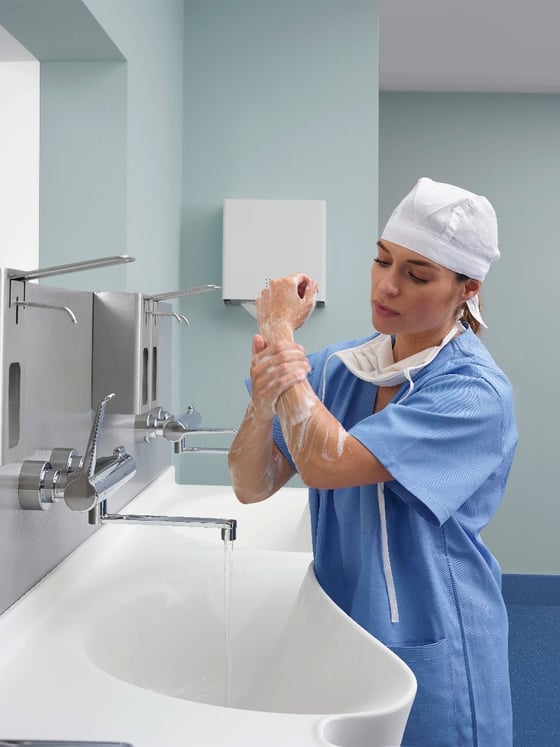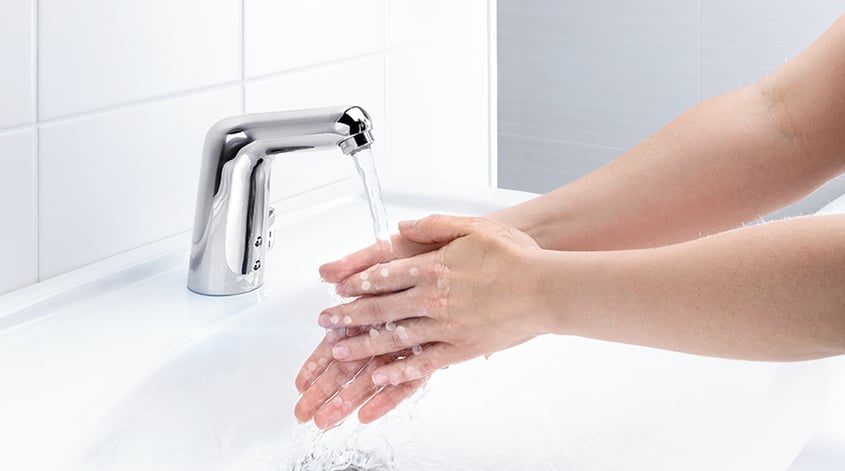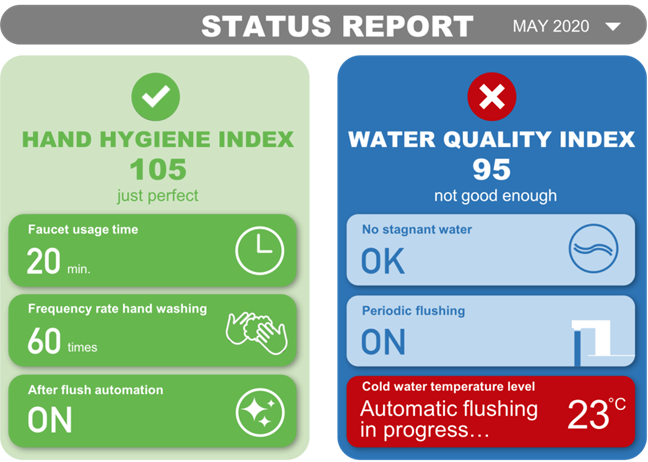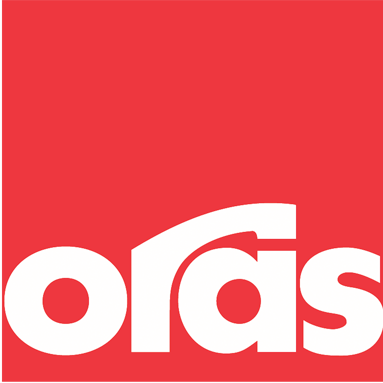Most of today’s hospitals are left with no other option than relying on direct observation and a general trust in staff and visitors to comply with hand hygiene standards. However, this often comes with flaws. Luckily, the future is just around the corner: By integrating smart hygiene monitoring features into existing installations, hospitals can track and improve hand hygiene based on data and real-time feedback.
 In the past years, ensuring proper hand and water hygiene has moved to the very top of the agenda, both for building operators and project planners. Especially the medical industry has experienced pressure from all sides to upgrade their buildings’ sanitary installations and enforce higher hygiene standards.
In the past years, ensuring proper hand and water hygiene has moved to the very top of the agenda, both for building operators and project planners. Especially the medical industry has experienced pressure from all sides to upgrade their buildings’ sanitary installations and enforce higher hygiene standards.
But when it comes to hand hygiene, we often only think of touchless installations to reduce infection risk. And while that’s a great start, the future requires us to look beyond and move towards new hand hygiene standards that are based on playful incentives and data analysis.
Let’s have a look at tomorrow’s digital services. Here’s how integrated hygiene can change the future of hand hygiene in medical buildings.
Why is integrated hand hygiene important in the first place?

According to the WHO, 10% of patients globally acquire a Healthcare-Associated Infection, which can be caused by poor hand hygiene in the most critical spaces. And too often, hospitals lack access to data on the level of hand hygiene compliance among their staff.
By installing smart monitoring systems, hospitals can provide real-time feedback, guiding staff and visitors through the correct hand washing routine while also analysing and improving compliance to hygiene requirements based on individual hand hygiene habits and patient contact.
What are integrated sensors and how do they work?
Today, we can already see more and more sensors integrated into multiple applications, such as showerheads to, for example, track water consumption and temperature.
“Integrating smart sensors with real-time feedback into faucets is only a natural step from here. This can be a major game-changer for how we, in the future, will talk about hand hygiene and handwashing habits,” says Juhani Lempinen, Product Category Manager, Smart & Digital Business at Oras Group.
The sensor comes as a miniature turbine, which uses water flow to generate electricity (removing the need for a battery) and measures water flow, consumption and water temperature during a faucet’s operation.
“A major benefit of these turbines is that they can run alongside any faucet model, whether manual or automatic. This also means that they can be flexibly installed into new as well as retrofitted into existing buildings, no matter the faucets’ brand,” Juhani Lempinen continues.
As the measuring module can be installed as a single unit under the sink, buildings don’t need to replace their existing faucets if they decide to upscale their installations.
Future digital services create new hygiene standards

Data can help drive improvements in handwashing behaviour and enable hospitals to create a global, data-based water quality index.
With the rise of connected systems that use multiple IoT sensors, information can be collected in a central location, such as a service cloud online storage. This allows building managers to access data to report, create actionable insights and shape awareness on hand and water hygiene via smart monitoring dashboards.
With access to users’ data in the entire building, hospitals can create automated reports and documentation of usage and (re)evaluate current practices to, for example, improve water hygiene programs directed to prevent the spread of legionella.
At the same time, tailored hygiene protocols for different types of rooms (think: patient rooms, operating rooms, public bathrooms) can show staff whether and how to properly sanitise a room and set goals for compliance based on the results.
Real-time feedback that improves handwashing habits
Apart from enabling monitoring, controlling and reporting, additional features such as an integrated handwashing coach can provide real-time feedback and influence users' handwashing habits.
“Digital faucets can become the personal trainer of handwashing for healthcare professionals and visitors,” Juhani Lempinen explains. “An interactive screen that’s connected to the faucet and, for example, installed above the washbasin, can address users with real-time visual feedback and playful nudges to improve handwashing routines. At the moment, we have several pilot projects up and running across Europe and have seen great improvements in users’ hand washing routines.”
This data can eventually help drive improvements in handwashing behaviour and enable hospitals to create a global, data-based water quality index.
What can we expect in the future?
With our everyday installations getting smarter and more connected, we can expect additional intelligent features to add extra comfort to users and building operators.
With the increase of data collected and stored in service clouds, building operators can manage and control installations comfortably and remotely via a monitoring dashboard. Easy localisation of each of the buildings’ fittings and their status can help identify malfunctions and leakages to prevent breakdowns or predict future maintenance issues. It would allow them to, for example, activate flushing or block a faucet remotely based on diagnostic error messages related to detected untypical behaviour.
An integrated hand hygiene system is not a wild future aspiration anymore. In fact, it's already a live solution that’s currently under heavy testing all over Europe.
With data recorded in more than 12 testing stations (ranging from airports to kindergartens and hospitals) leading to insights on more than 200,000 water extractions, we’re looking ahead towards a data-driven future.








